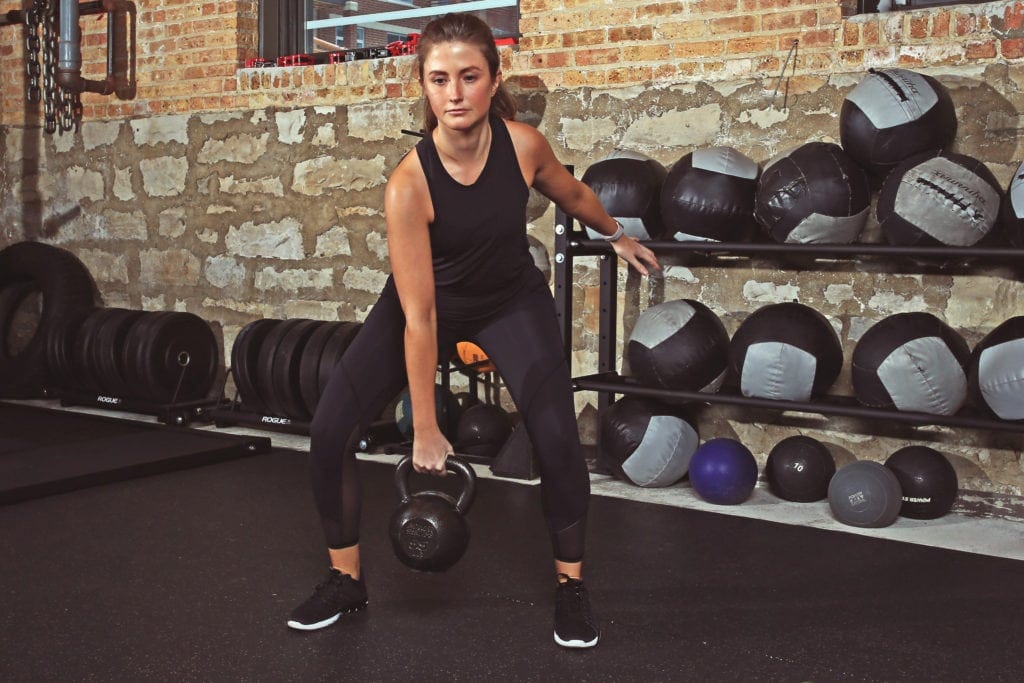6 Reasons to Swap Those Barbells for Kettlebells
You know those rainbow colored, circular things on the floor of many gyms? Those are kettlebells—and boy, are they good for you.

There’s nothing wrong with using barbells or dumbbells, but incorporating kettlebells into your fitness regimen can boost your performance and really power those muscles.
To be clear, the kettle bell is not “better” than the dumbbell. “Rather it is a different tool that excels in training certain movement patterns where the dumbbell may fall short,” says Sam Capogrosso, Master Trainer at Burn 60.
For instance, “[Kettlebells] are great for high energy workouts designed to increase power, cardiovascular strength and endurance,” says Katie Dunlop, creator of Love Sweat Fitness. Dumbbells, on the other hand, are free weights that come in pairs of equal weight and are great for strength-focused workouts, especially those with a focus on joint isolation, like bicep curls, she explains.
Here are a few reasons to start working with kettlebells in the gym.
They Burn Tons of Fat
“If your goal is to increase cardiovascular endurance and strength and burn fat, the kettlebell is going to be the best choice,” she says. “Since there is a singular handle to grip and the weight is isolated in one spot, it’s easier to hold and great for explosive, higher rep exercises, like Russian twists,” she says.
So, you get the benefits of added weight to build strength, while still effectively moving through HIIT style workouts to burn serious calories, she explains.
They Can Target the Glutes Really Well
You’ll really work your behind with a kettlebell. “While kettlebells are amazing for big explosive exercises, it can also be extremely beneficial for slower movements to help you really focus on muscle groups, like the glutes, as you get comfortable with the kettlebell itself,” says Dunlop. These include the deadlift, a reverse lunge and press, and even jumping lunges for a plyometric, calorie-torching move.
They’re Easier to Swing
Basically, the primary difference between kettlebells and dumbbells lies in where the weight is centered. “A dumbbell’s weight is distributed evenly to each side of its handle. For example, a 15 lb dumbbell has two 7.5 lb weights set to each side of a straight handle that connects the two weights,” says Capogrosso.
And, it’s this positioning that makes the kettlebell easier to swing through the legs. “A kettlebell’s weight, on the other hand, is centered in one mass beneath a curved handle,” he says. “This small, but significant difference makes a kettle bell far easier to swing dynamically between one’s legs,”Capogrosso says.
They Improve Other Forms of Training
The kettlebell handle is generally more challenging to hold onto than a standard dumbbell, and when combined with swinging movements, the exercises tax your grip strength and activate muscles throughout the upper and lower body, says Capogrosso.
And, working these muscles help with training in other areas. “For those of you interested in martial arts, climbing, or perhaps just carrying shopping bags to and from one’s car, the development of these muscles is invaluable to say the least,” he says.
They Increase Mobility
Being able to swing the kettelbell around and having continuous flow allows the body to activate more muscles, especially ones that you aren’t used to activating, explains Scott Forrester, Master Trainer at Burn 60. For instance, “going from a seated position to a standing position with a kettlebell, such as a Turkish Get-up, helps the body use multiple joints all at once,” he says.
The hip hinge motion of kettlebell swings is great for working the body through the hips in other areas, too. “This motion increases one’s ability to maximize force production through one’s hips. Regularly training the hip hinge motion therefore results in faster sprints, higher jumps, and more dynamic movement on the track, field, or even while attempting to keep up with one’s children,” says Capogrosso.
They Build Endurance
Burpees and mountain climbers are great to help keep your heart rate elevated, but using kettlebells can add some variation to your simple workouts to help you go longer.
“Try hitting some swings for 20-40 seconds and watch your heart rate skyrocket. Do these in an interval workout and you’ll swing that fat off in no time,” says Forrester. “Swings are a great full body movement where you target hip and glute activation while also strengthening grip strength by merely holding onto the horn,” he says.












